This post contains affiliate links. We may get paid an affiliate commission if you buy something or take an action after clicking one of the links on this web page.
Last Updated: August 2, 2019
The Benchmade 300 is a knife that I originally passed on reviewing. This wasn’t an easy decision. As Benchmade’s first flipper, this is an important knife. But initial reports said that the flipping action was weak, and the knife seemed chunky. I was turned off for those reasons. Rather than going through the motions of reviewing a knife that I did not want to review, I decided to focus my efforts elsewhere.
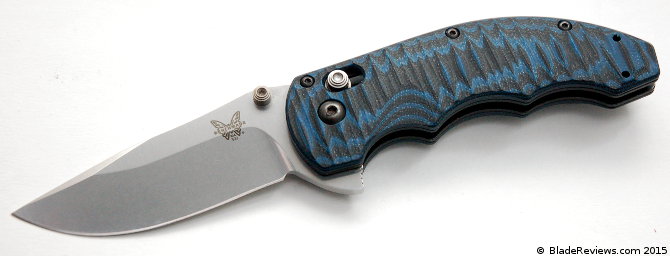
Buy the Benchmade 300 at BladeHQ
I think it was a mistake to ignore the 300. In a sea of somewhat boring and predictable Benchmade offerings, this knife offered a glimpse of something different for the company; even if it’s simply hitching on to the flipper wagon.
As I review some of Benchmade’s 2016 models, I see a few more flippers in the mix. I can’t help but wonder how the 300 has informed these new flippers, and future knives for Benchmade. That is what really drew me to examine the 300.
General Dimensions and Blade Details
The 300 has an overall length of 7.36″, a 3.18″ blade, weighs 4.85 ounces, and is made in the U.S.A. Technically, my knife with the black and blue G-10 handle scales is referred to as the 300-1. The original 300 comes with sand colored peel-ply G-10 handle scales and satin hardware. Beyond the scales and hardware you have the same knife. I am going to refer to my 300-1 as simply a “300” throughout this review.
The 300 knife is designed by Butch Ball, a nice man that I had the pleasure of meeting at the 2015 Blade Show. The 300 is aimed at the Every Day Carry (EDC) market. It is on the large side for my style of daily carry, although it makes for a nice “nights and weekends” knife when I can dress a little more casually. I have used it in an EDC capacity, and can see how others might do the same.
The 300 features a wide clip point blade. This is a dramatic blade that juts from the handle with a pronounced thumb ramp, deep belly, and large flipper. The high flat grind and bright satin finish contrast sharply with the dark handle and black hardware. There is a thin swedge that terminates with a fine tip.
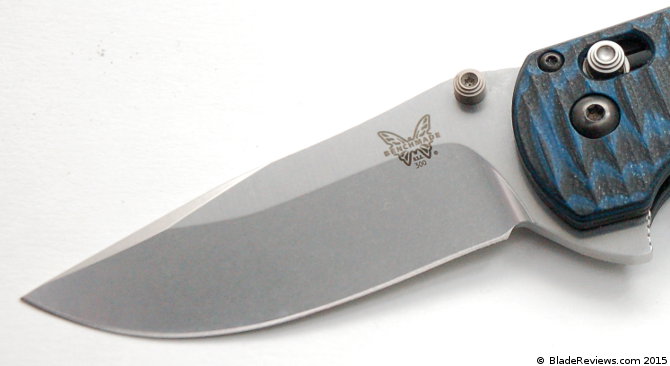
In practice the 300 proved itself to be a capable slicer. Although the blade stock is relatively thick, this is a wide blade, and the high flat grind gets thin behind the edge. Standard fare like cardboard, rope, and apples are easily cleaved by the 300. A deep belly and strong tip are hallmarks of clip point blades, and these features aid the 300 in food prep and penetrating cuts. This versatile blade shape is well rounded and the 300 should handle most EDC chores without complaint.
Benchmade decided on 154CM for the blade steel. Knife fans will already know that this is a proven stainless steel, although it is now considered a mid range steel. Personally, I remain a big fan of 154CM. It takes a beautiful edge, holds it well, and is easy to sharpen. Like all steels (even stainless steels) you will need to keep the knife clean to avoid corrosion, but if adequately maintained this is an excellent working steel ideally suited for daily use.
Handle, Ergonomics, and Pocket Clip
My 300 came with 3-d machined layered blue and black G10 handle scales over blackened stainless steel liners (again, technically this is considered the 300-1 in Benchmade’s catalog). The knife is held together with torx-head fasteners and 2 blackened stand offs. The 300 originally is offered in sand colored peel ply G10 with odd grooves cut into it. It was different, and I appreciate that, but it did not appeal to me. The blue/black G10 is a little more toned down, but it still offers the end user something besides a plain black handle. The steel liners have been skeletonized extensively. The fit and finish is excellent on my knife.
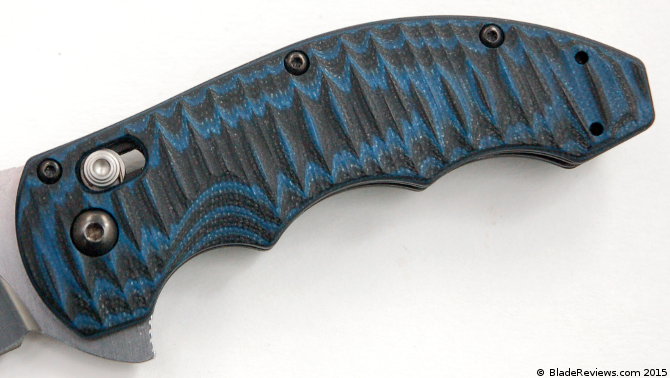
The entire knife looks wide and unwieldy, but it all makes sense in hand. There are a series of finger grooves, that I typically am not a huge fan of, but I was pleasantly surprised with how natural the 300 fit my fingers (I take a “large” glove for reference). The thumb ramp features 3 shallow notches (jimping) that more index your thumb than hold it in place. This is a stark contrast from the toothy jimping on the Griptilian.
The machined G10 handle scales offer traction, but the texture is not aggressive like peel ply G-10. The texture is similar to the handles of the Volli or the Bedlam. If you prefer the traction and feel of a peel ply G-10 handle, then check out the tan colored version of this knife.
In practice this is a comfortable work knife. It stayed in my hand and did not irritate me in use. The finger grooves actually worked here for my hand.
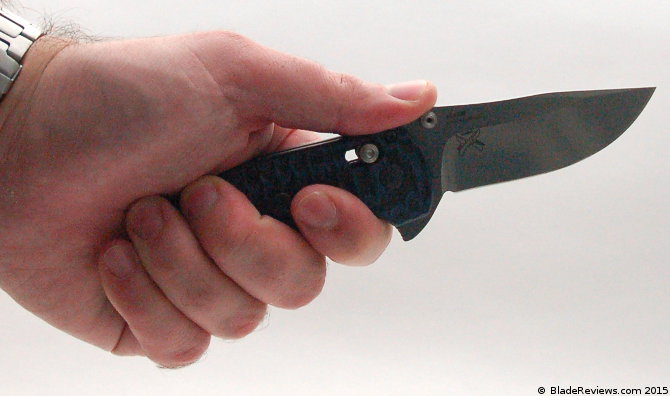
Benchmade chose a black parkerized deep carry pocket clip, and situated the 300 for ambidextrous tip up carry. I like the deep carry clip and clip placement. The 300 buries deep into the pocket and carries well considering this is a larger knife. And I do consider the 300 to be a larger knife. Despite having a sub 3.5″ blade it is still a wide and thick knife. For what it is, I think the 300 carries pretty well.
Deployment and Lockup
The big draw to the 300 is that it is Benchmade’s first flipper, and that this is an axis lock flipper. In a perfect world we would get exceptional flipping action combined with the safety and convenience of the axis lock.
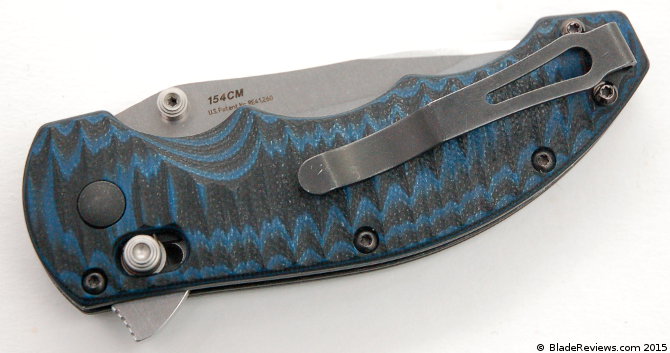
I am here to report that this knife does not flip like a traditional liner lock or frame lock flipper. The axis lock simply does not provide enough resistance (or “detent strength” if you were to compare it to a traditional detent driven flipper) to provide snappy flipping action. However, my knife was not a total flipper fail. If you use a strong lightswitch flick it is possible to flip the knife completely open without using your wrist. It takes some practice, and doesn’t compare to a ball detent driven flipper, but the knife does flip open this way. On a “1 to 10” scale, I’d say this is a 3. It still flips better than my 3” XM-18 did, but this isn’t a Shirogorov by any means.
Benchmade wisely chose to include ambidextrous thumb studs on the 300. This is a more reliable means of opening the blade, and provides the user some options in how they want to manipulate their 300. The thumb studs deploy the blade as easily as a Griptilian or any other axis lock knife with thumb studs. And of course you can use the axis lock to flick the knife open as well.
Speaking of axis locks, the axis lock on my 300 is excellent. My knife is rock solid and devoid of any horizontal or vertical blade play. I remain a big fan of the axis lock because it is strong, easy to use, is fully ambidextrous, and you do not need to put your fingers in the path of the blade to close the knife.
Blade centering is near perfect on my 300.
Benchmade 300 Review – Final Thoughts
I am glad I finally bought a 300. This is an interesting and important knife for Benchmade, and I was pleasantly surprised by it. The big question is “How well does it flip?” I am here to confirm that the flipping action is nothing to write home about. It works, but requires practice and a strong index finger.
If we examine the other aspects of the 300 it reveals a thoughtful and well made knife. The fit and finish is good, the knife cuts well, the steel is good, the handle is comfortable, and the 300 carries decently given its size.
It’s a thick and larger knife, so don’t expect this to carry like a Valet, but for a sturdy working knife this fits the bill. If you are a fan of knives like the Rift, then I think you would appreciate the 300.
This is an interesting first attempt at an axis lock flipper from BM. I wouldn’t call it a home run, but I am glad I picked one up. I am curious to see how Benchmade’s new 2016 flippers stack up against the 300, and plan to review at least one of them in the not so distant future.
In closing, don’t buy the 300 if you are expecting a Zero Tolerance grade flipper with an axis lock. The flipping action is simply not up to par with a ZT. Buy the 300 if you are a Benchmade fan that likes larger EDC knives, and wants to try something a little different.
- HIGH-QUALITY: The 154CM stainless steel blade is tough, rust resistant, and holds an edge well. The G10 handle is durable, impervious to moisture, and stable under extreme temperatures, making it great for outdoor use.
- WELL-DESIGNED: The AXIS Flipper 300 offers the speed and function of AXIS Assist, with the convenience of a flipper. The 300 can be opened and closed quickly and single-handedly.
- COMFORTABLE: The 300's contoured handle is attractive and comfortable to use and hold. The reversible pocket clip offers ultimate accessibility.
- VERSATILE: The AXIS Flipper 300's drop-point, utility blade style and all-around functionality make it ideal for everyday carry.
I recommend purchasing the Benchmade 300 at Amazon or BladeHQ. Please consider that purchasing anything through any of the links on this website helps support BladeReviews.com, and keeps the site going. As always, any and all support is greatly appreciated. Thank you very much.
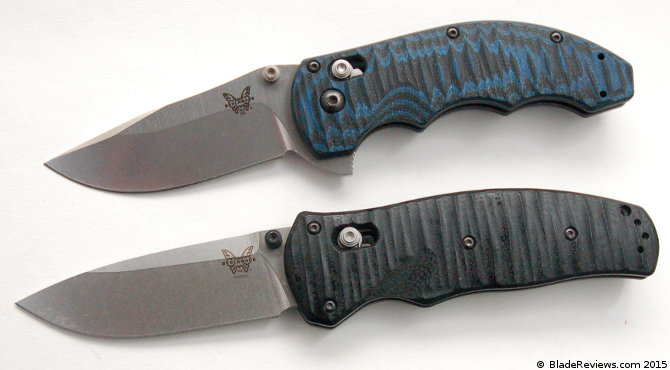

Great review,
I’m surprised to hear it doesn’t flip as well as the liner/frame locks. For some reason I had in my head that the axis flipper combo would flip like a daemon.
Personally the finger grooves put me off a bit, but look forward to some of benchmades future flipper offerings.
Matt
Thank you, Matt. The axis lock simply doesn’t provide the resistance of a well tuned detent. It’s definitely a quirky knife. I am curious to check out some of their new flippers to see what direction BM decided to take this in.
Dan
Solid review, Dan; thanks for that! I bought one of these about a year ago and despite the fact that it does fly open like a rocket, I appreciate this knife for the way that it DOES come open. Perhaps mine is the exception, but it almost always flips completely open – just not terribly fast. It’s like it’s a metered, steady open. Rock solid lockup and perfect centering, too. It’s the knife that made me believe in the Axis lock. (My Mini Ritter Grip is a great knife but I’ve always read that the Axis lock needs a certain amount of blade play in order to work properly – and the orange Mini in my office definitely is not the exception to this; I can’t get it to center up to save my life!)
Thanks for taking a look at it with a more seasoned eye than some of the other reviews of this knife. It DOES have its redeeming qualities, and the fit/finish is easily as good as any knife that I’ve got. It’s a solid, working knife that gets it done…and at the end of the day, that’s what we’re all here for, right?
Hey Ryan,
Thanks for stopping by. My knife actually flips pretty good once I dialed in my technique. The 300 is a little funky, but I agree, it’s a solid working knife and it gets it done. I like that aspect about the 300 and generally found something oddly endearing about the knife – even if it’s a little different.
Best,
Dan
Dan, I’m looking for a great edc flipper because I’ve never had one and want one with an easy action that flips easily without using my wrist. Could you give me a couple recommendations?
Jacob,
Sure, do you have a budget in mind? How big of a knife are you looking for? I’d say offhand, anything by Kizer or Zero Tolerance should be good. They make some of the most consistently reliable flippers I have reviewed. It should go without saying, but I would not recommend the 300-1 for a good flipper.
Dan